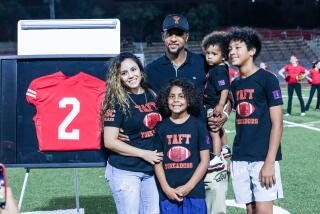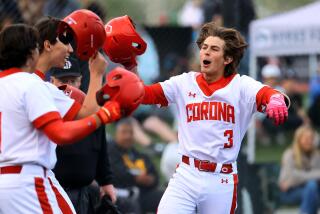Fullerton’s Most Seasoned Player
- Share via
Fullerton isn’t the first place one thinks of as a great baseball town. But Ed Hart says it is. And not just because of Cal State Fullerton’s NCAA Division I championship last year, though that’s part of it. Nor is it the arrival of the Fullerton Flyers, the minor league team of which Hart is the general manager, though that counts too.
The rest requires you to head downtown, a few miles past Goodwin Field, where the Cal State Fullerton Titans -- and beginning this June, the Flyers -- play, to another ballpark, much older, full of old memories and new ones being made today.
Duane Winters Field at Amerige Park looks much as it did in old photographs, when such baseball greats as Satchel Paige and Joe DiMaggio took the field.
Because of a termite infestation in 1965, the stands are concrete now, and the old timber wall in the outfield has been replaced with a chain-link fence. The center-field segment of the fence is missing, and well-hit line drives that dart past outfielders can end up bouncing down the street. But that can take quite a shot. It’s about 400 feet from home plate to dead center.
Though the ballpark remains largely unchanged, the rest of the park has undergone development over the years. Next to the field on the third-base side is an old beige building moved from downtown in the ‘50s that advertises “Amerige Bros. Real Estate, Loans, Insurance.” Adjacent to that is the city’s Senior Center, and across the parking lot from the field is the Boys and Girls Club.
The park also offers tennis facilities and, when baseball teams aren’t on the diamond, space for soccer fields. Still, Amerige remains what it is has been ever since it was used for pickup games more than 75 years ago: a place to play baseball.
Nowadays, the park is dominated by young teens playing in Fullerton’s Pony Baseball program. The feeling among local coaches and managers is that there’s no better place to learn the game than on a field where baseball legends once played.
For years, what is now Amerige Park was an empty lot bordered by a cornfield. Lee Kavanagh, a longtime Fullerton resident who played at the park in the late 1920s, remembered Amerige in a Times article this way: “No stands. No fences. But all the ballplayers in town came there to play.”
Then, in 1934, the city built a small wooden grandstand. The first team to play there wore uniforms donated by Orkins Department Store. They advertised “Orkins Dept. Store Fullerton” across the jerseys. That proved to be a bit of a mouthful for sportswriters, so the newspapers simply referred to the team as the Fullerton Merchants.
In 1935, the Hollywood Stars, a minor league team in the Pacific Coast League owned by celebrities such as Gary Cooper and Gene Autry, moved in for spring training. A year later, the Stars moved to San Diego and became the Padres, but they liked Amerige so much they returned for spring training in ’36.
The Philadelphia Athletics, the Pittsburgh Pirates, the Portland Beavers, the Sacramento Solons, the San Francisco Seals and the Los Angeles Angels all played exhibition games at Amerige.
With them came such players as Joseph Floyd Vaughan, nicknamed “Arky,” who went on to set batting records and have his photo on a Wheaties box. There was legendary pitcher Satchel Paige, who took the field during a barnstorming tour. Joe DiMaggio was there, too, traveling south with the Seals before the Yankees called him up to the majors and superstardom.
The same year the Stars came for the spring, another kind of Hollywood star descended on Amerige. Director Ray Enright brought his production crew to Fullerton to shoot a film called “Alibi Ike.” A comedy starring Joe E. Brown and Olivia de Havilland, the film was about a rookie pitcher for the Cubs who tormented his manager and fiancee with alibis and excuses for all his quirks.
Production stills show Amerige as it must have looked during the old exhibition games of the time: the infield populated by men in baggy, pinstriped uniforms with crooked hats and well-beaten mitts, the grandstands down both baselines full of fans, and, beyond the outfield fence, Plymouth coupes and Buick sedans motoring past City Hall on Commonwealth.
By the 1950s and ‘60s, use of Amerige Park expanded beyond the Pacific Coast League’s spring training. It became the home of Pony Baseball in 1957. When Major League Baseball came to California during the expansion period of the 1960s, Pacific Coast League activity diminished, leaving Amerige in the hands of youth sports, and the city’s young ballplayers have kept the baselines well trodden and the grandstand full every season for half a century.
On a recent Saturday, parents and kids filtered into the 500-person-capacity stands for the 2005 Pony Baseball opening ceremonies. As they took their seats, the fans could look through the bunting-decked backstop, out over the outfield fence and see the white adobe clock tower of the Fullerton police station, the fire escapes of the old buildings a few blocks away in downtown, the grassy crest of Coyote Hills, and beyond that, the snowcapped peak of Mt. Baldy through the thin haze.
Just before the ceremony, the stands started to tremble, and the kids who knew why all rushed to the top row to watch a freight train thunder past on the tracks behind the park. When the last car slid out of sight, they hopped back down to their parents as if the passing train meant it was time to start the show.
A swift breeze swept over the field in the wake of the train, tossing debris into the air and kept dead leaves and grass clippings hovering over the infield as high as the lights. When the air settled, Louie Arias, director of operations for the league, strolled out to home plate holding a microphone.
“Good morning, ladies and gentlemen, boys and girls,” he began. “You don’t know how glad it makes my heart to see you all here.”
A cheer rose up from the crowd.
Richard Ramirez, dean of student services at Fullerton College who grew up in town and played ball at Amerige, said, “As you look around here, you have a reference point of history.” Then he listed some of the greats who had played on the field, including current ballplayers Shawn Green and Sean Burroughs. He paused, pacing slowly, then added, “Twenty years from now you will look back and know you were a part of this.”
Ramirez meant the Pony League, the hot dogs, the beating sun, weekends at the ball field, Amerige Park, and now its longest and most important tradition, youth baseball. Everyone understood, especially Arias, who, as he sat on a bench after the ceremony watching the youngsters playing catch before the start of the first game, said, “It’s nice to be on a field where great players have played, but every player has his own destiny. Some of them come back to become leaders in the community.”
More to Read
Go beyond the scoreboard
Get the latest on L.A.'s teams in the daily Sports Report newsletter.
You may occasionally receive promotional content from the Los Angeles Times.










